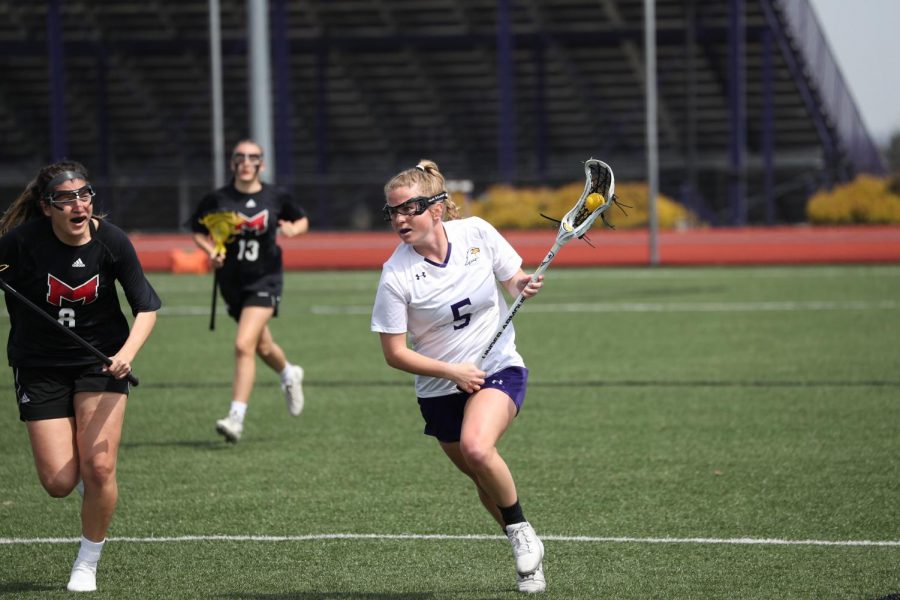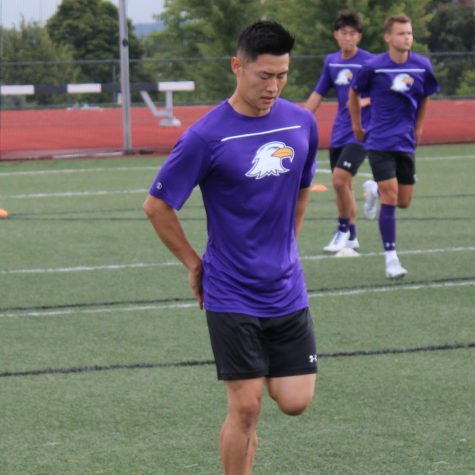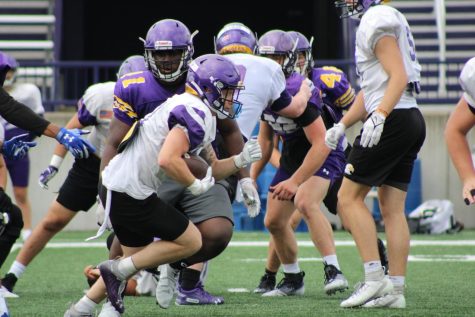Bringing new opportunities to campus: sports added in recent years
Women’s lacrosse saw its first season at AU in spring 2019.
February 20, 2020
In the past four years, Ashland University has added five new sports to the athletic department roster: women’s lacrosse, Esports, STUNT and the readmittance of men’s soccer and men’s tennis.
Al King, athletic director at AU, reports to the president with any sports-related ideas – such as adding them to the university. King tries to look at adding a sport a year in advance.
After bringing an idea to their meeting, the sport will be “torn apart” and studied by King, the president and five other people from athletics to see if adding the sport makes sense to AU.
They look at national trends, participation rates throughout the country, if it is popular in the midwest, the type of weather the sport requires and injury rates.
Then, they look at the AU-side of the sport: gym space, locker room space, outdoor facilities (or is there a facility close by that AU can use?).
Cost is a heavy player when thinking about adding a sport to AU. King and his associates try to project how many student athletes they would have and financially look at locker room space, travel, equipment and practice/game facilities.
Finally, they see if it is a GLIAC sponsored sport. If it is, athletes can compete for a conference title.
STUNT
These research questions cover the general process, but what about STUNT? Since it is such an emerging sport, King and Denise Farnsworth, AU head STUNT/ Cheer/ Dance Coach, took time to make sure this was the right decision.
Last school year, STUNT was going to be added, but without feeling 100 percent confident, King decided to wait. This year, King went to the Board of Trustees and STUNT was officially added on Nov. 11, 2019.
“I cried when I received the news, it was very emotional because this was something that we had been working on for so long,” Farnsworth said. “It is super exciting to be creating a brand new program here. I think about the fact that not many cheer coaches in the state of Ohio get to be full-time employees and I am blessed.”
STUNT is a spring sport that consists of four quarters, just like football or basketball. Each quarter is as follows: partner stunts, pyramids/tosses, jumps/tumbling and a team routine.
Each quarter is a short routine that both teams perform at the same time. The team that wins the round is awarded with a point.
The GLIAC needs to have six varsity STUNT teams competing in order to have a GLIAC championship. Davenport and AU have varsity STUNT programs, while Grand Valley and Ferris both have club level programs.
STUNT’s roster goal is 20-25 this first year and then get to 30-35. King said that the program seems to be taking off in the midwest region.
Just like all sports, travel needs to be planned. Michigan, Kentucky, Pennsylvania are not only places where STUNT is growing, but the team will not have to travel far from Ohio.
STUNT’s events will be held in Kates Gymnasium.
Esports
Another emerging sport in the United States is Esports. AU was, again, ahead of the curve when adding this rising-in-popularity sport.
AU was around the first of about 50 schools to add this varsity sport. Their roster has doubled in size in year two: 20-25 athletes to 40-45 athletes. Now, there are at least 170 schools who have added Esports.
Esports has six different games: League of Legends, Overwatch, CS:GO, Hearthstone, Fortnite and Super Smash Brothers Ultimate. Each student specializes in one of those games, making six separate teams, all falling under the same umbrella of Esports.
To get recruited, students need to have a certain skill level in those games. Because of that, they come in already owning the game and then just log into their account and play here at AU. Players’ statistics are easily available online, so those are being taken into account, in addition to their tryout.
Since Esports is not part of the NCAA or GLIAC (yet), the National Association of Collegiate Esports is what the sport looks to as a governing figure. Academic-wise, Esports athletes are treated the same as NCAA sponsored athletes.
The athlete’s mindset greatly affects their overall performance. Buchanan teaches his athletes to learn so the athlete can figure out how they learn best and always be ready to change to keep up with the many changes in the game.
Another thing he teaches is avoiding tilt, a term Esports picked up from poker. If a player is struggling, they will get upset and the mindset will be stuck, making it nearly impossible to actively learn.
“If you have a bad mindset during practice, you’re not going to improve probably at all,” Buchanan said. “It’s really important that we teach our students to have good composure, learn good meditation habits to get themselves in the zone and be able to constantly make the most of their practices.”
Women’s lacrosse
As an NCAA recognized and GLIAC sport and in its second year, women’s lacrosse is excited to get their season underway starting Feb. 23, 2020.
After becoming an official sport at AU, Shaun Williamson, head women’s lacrosse coach, realized that his players did not need to be told that this process was going to take a while.
“Our administration has been very supportive and helpful,” Williamson said. “But like at any school, starting a program takes time and many years to do it correctly and we are still in the middle of that. Our players have great work ethics and a desire to build a winning tradition for the lacrosse program.”
Their first season, the team went 5-11, a record Williamson was pleased with. There were three new-to-the-GLIAC teams that AU defeated.
Then-sophomore, Sofia Michael, was the team’s first all conference player last year.
“We return the heart of our team from last year and added some talented freshmen and transfers to our group for this year, which has seen us become a vastly improved team,” Williamson said.
Women’s lacrosse repurposed the soccer field, saving the university money. With the relined field, the lacrosse team had a place to practice.
“Get the word out,” King said. “Get potential student athletes to know that we’re going to have this sport. Ashland had never had women’s lacrosse, so here we are bringing it in, and we’ve got to try to build enthusiasm, get the student body to understand what it is, get our fanbase to understand what it is and get our staff to know how to work a lacrosse game.”
Athletics and the future
It is clear that students looking to be an athlete at AU have many new opportunities to get ahead of the game and compete in new sports.
“We’re trying, in athletics, to do as many things as we can to give people opportunities,” King said. “I want to get more opportunities for women athletes. Lacrosse does that and STUNT’s going to do that. If we get STUNT 25-30 people, we have lacrosse at 25-28, there’s 60 opportunities for women.”
Financially, adding sports to AU makes sense. An increase in enrollment means more money for the university. Recognition for academics in sports helps the school’s reputation as well.
“I do think with some of these sports, you get a chance to spread AU’s name,” King said. “For Esports, we were mentioned in Forbes magazine and Good Morning America. I think it puts you into a new arena where it gets the word out to a different audience and different states…the university benefits any time we can bring a different activity here and that’s what we try to do.”
Head coach of men’s soccer Oliver Slawson believes that adding new teams will not only bring students to AU, but it also means bringing new coaches, administrators and student athletes to add to AU’s athletic-academic reputation.
“I think it’s great that they’re adding new teams,” Slawson said. “I’m looking forward to hopefully watching those teams develop and grow and be given the support that they need to be competitive in their fields and I hope men’s soccer can be on that trajectory as well of being a program that the school is proud of and support in a manner that allows student athletes to feel like they’re equals.”
By separating themselves from the college sports pack, AU has gained recognition from national media and can get their programs adjusted early, before the trends become the norm.
“You do the best research you can and go from there, as you get into it, you learn,” King said.










